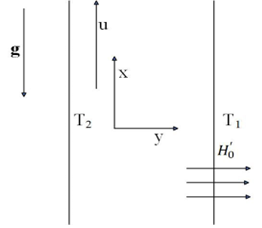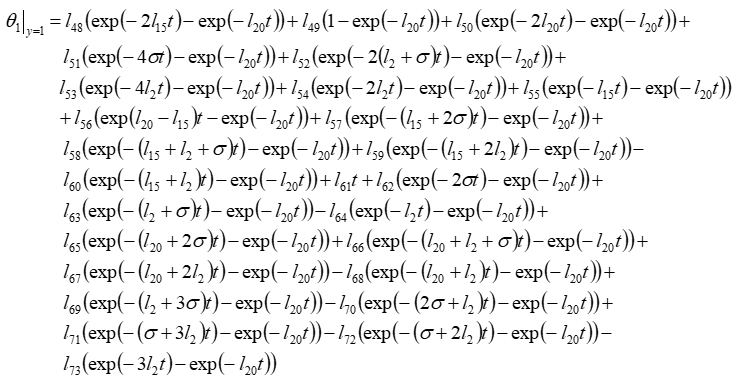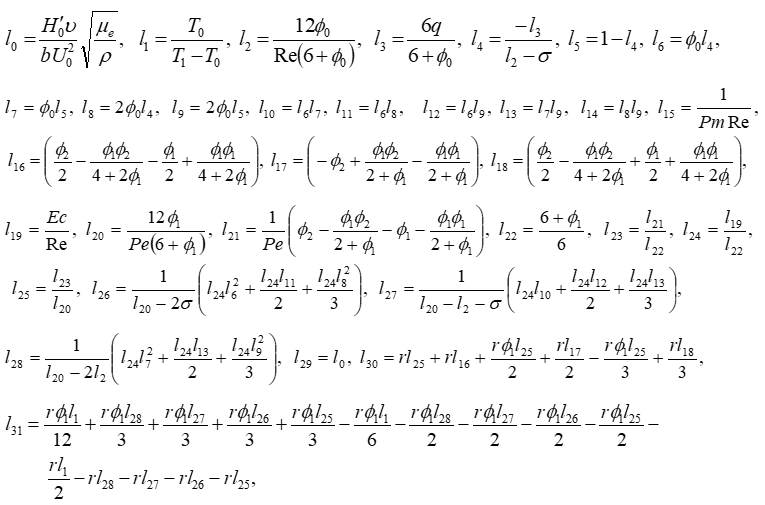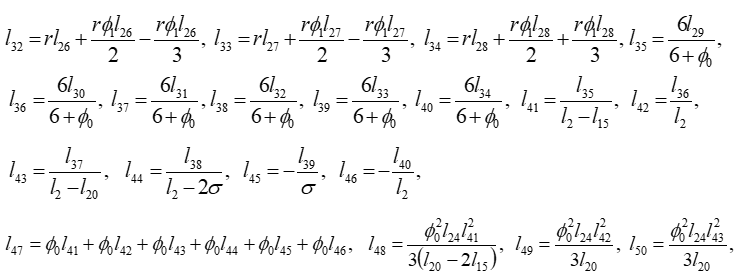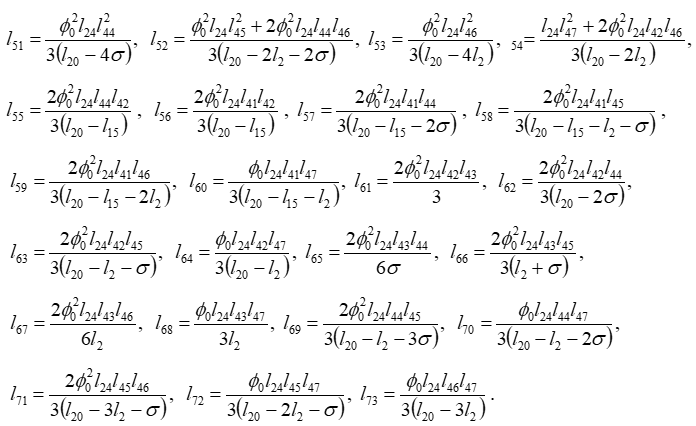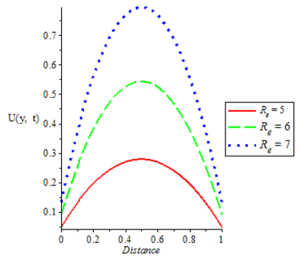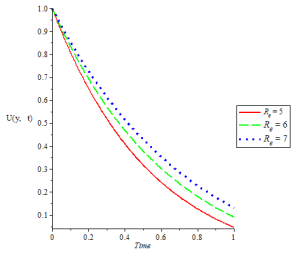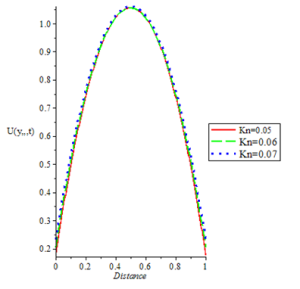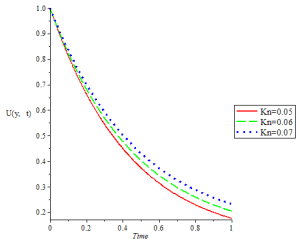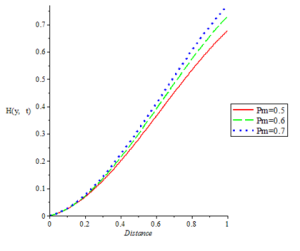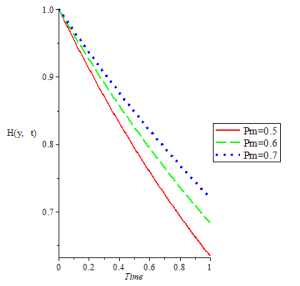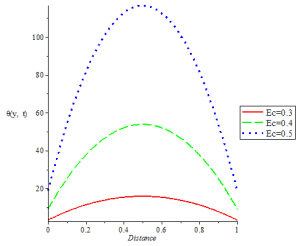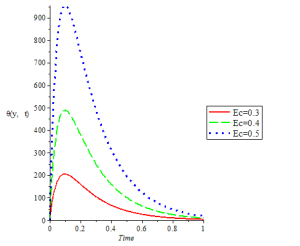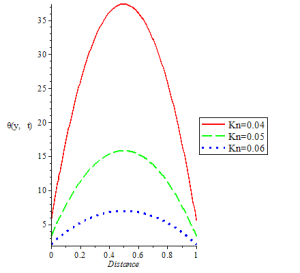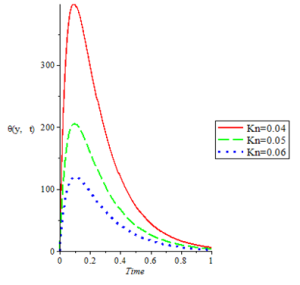Unsteady MHD Free Convection Flow of Fluid in Micro channel in the Presence of Viscous Dissipation Between Vertical Parallel Two Walls
- Ahmed D. Abubakar
- Ibrahim Baba S. Mohammed
- Ahmed G. Saleh
- 32-47
- Apr 26, 2024
- Mathematics
Unsteady MHD Free Convection Flow of Fluid in Micro Channel in the Presence of Viscous Dissipation Between Vertical Parallel Two Walls
Ahmed D. Abubakar1,*, Ibrahim Baba S. Mohammed2, Ahmed G. Saleh3
1Department of Mathematics, Federal University Gashua, Nigeria.
2Department of Mathematics, Federal Polytechnic, Bida, Nigeria.
3Almaarif College of Nursing, Midwifery and Health Sciences Potiskum, Nigeria.
*Corresponding Author
DOI: https://doi.org/10.51584/IJRIAS.2024.90403
Received: 27 February 2024; Revised: 14 March 2024; Accepted: 19 March 2024; Published: 26 April 2024
ABSTRACT
Convection is a process by which heat is transferred by movement of a heated water. The phenomenon where heat transfer process is driven by natural fluid motion due to temperature and density gradients is called free convection. The effect of slip velocity on thermal behaviours of MHD free convection flow over a vertical parallel two walls is the focus of this research. The mathematical equations which described the phenomenom includes momentum, magnetic field and energy equations. Condition for the existence and uniqueness of solution of the model equations were established using the approach of Lipschitz continuity. The model equations in dimensionless form were solved using Olayiwola’s generalized polynomial approximation method (OGPAM). The results obtained which contains the dimensionless parameters were presented graphically and discussed. It was observed that increase in Reynolds number and Knudsen number both enhanced the velocity distribution at the two walls. Also, magnetic field and temperature field were enhanced by magnetic prandtl number and Eckert number respectively.
Keywords and Phrases: MHD, free convection flow, viscous dissipation, Knudsen number, OGPAM.
INTRODUCTION
Magneto hydrodynamic (MHD) is an important area of studies which has its wide applications in power generation, cooling of electrical/electronic equipment and liquid metal processing. A lot of studies have been carried out and findings were reported on MHD free convection flow of fluid in micro chnnel on a vertical parallel two plates. Free convection slip flow of an exothermic fluid in a convectively heated vertical channel was investigated by Hamza [9]. His numerical simulation show that the formation of flow is strongly dependent on the fluid parameters. Hamza et al.[10] studied unsteady MHD free convection flow of an exothermic fluid in a convectively heated vertical channel filled with porous medium. The time-dependent governing equations were analysed numerically using finite difference method. A minor rise in the Hartman number was discovred which slows down the fluid flow.
Uniform transverse magnetic field on the time-dependent free convective fluid flow of a nanofluid with generalized heat transport amongst two parallel plates have been analytically investigated by Ahmed et al. [1]. However, Laplace transform technique and fractional derivatives of the Wright’s functions were used to obtained the closed form of the temperature field. Moreso, effects of the dimensionless parameters on the nanofluid flow and heat transfer are graphically presented. The integral transform technique is used for finding the exact solutions of the fractional governing differential equations for fluid temperature and velocity field in the work of Hajizadeh et al. [8] who considered Free convection flow of nano fluids between two vertical plates with damped heat flux. Analysis of the memory parameter on the velocity and temperature fields was done, while comparison between the fluid with thermal memory and the ordinary fluid were made.Other related literatures cited in this area include [3, 28, 7].
Jha and Aina [13] analytically presents the impact of induced magnetic field on MHD mixed convection flow in vertical micro channel formed by conducting and non-conducting infinite vertical parallel walls. It was observed that the effect of the induced magnetic field enhanced the velocity profiles compare to the situation of neglecting the magnetic field. Similar studies which considred MHD natural convection flow in vertical micro channel formed by two electrically non-conducting infinite vertical parallel walls was investigated by Jha and Aina [12]. Generally, the findings from their study agreed with the existing literature of Chen and Weng [4]. In a related work of Shu et al.[25], fluid velocity slip and temperature jump at a solid surface was investigated.
In a similar studies, Mahjabin and Alim [16] presents the effect of Hartmann number on MHD free convective flow of fluid in a square cavity with a heated cone of different orientation. Their findings shows that Hartman number only have an effect for a large Rayleigh numbers. Moreso, with increasing , heat transfer mode on MHD fluid gradually changes from convection to conduction. Heat transfer analysis of arrhenius-controlled free convective hydro magnetic flow in a micro-channel was investigated by Ojemeri and Hamza [23]. They obsereved that heat absorption overwhelms fluid flow whereas heat generation creates the opposite condition. In addition, they compared their results with the existing literature written by Jha et al. [11]. Ramadan [20] presemts both steady and unsteady heat convection in axisym metric stagnation point flow with momentum and heat slip effects. Their findings established a relation between the specific heat ratio and Prandtl number which characterizes the variation of the Nusselt number with the slip factor.
Dwivedi and Singh [6] investigated unsteady free convective hydro magnetic flow in an infinite vertical cylinder with hall current and heat source. The effects of the dimensionless parameters on both temperature and velocity were graphically presented. However, it was observed that temperature as well as velocity enhances and finally gets to its steady state thereafter. Investigation on the time-dependent free convection MHD of a nanofluid under the influence of radiation and heat generation over a vertical surface was carried out by Rao et al. [22]. Numerical solutions of equations governing the flow were obtained by Laplace transform algorithm and symbolic computation software MATLAB. Effects of MHD, heat generation, radiation and nanoparticle volume concentration on the velocity, energy and mass descriptions were shown graphically. The Nusselt number, Sherwood number and skin friction coefficient were also investigated. In a similar work written by Na et al. [18], their findings reveal that iincreasing the value of fractional parameter increased the absolute temperature in the Maxwell fluid flow between vertical walls with damped shear and heat flux. Comparison between ordinary viscous and fractional viscous fluid were also presented graphically .
Investigation by finite difference method on transient laminar natural convective mass transfer stream of an in compressible thick liquid precedent a vertically inclined plate by means of heat source and sink in a MHD radiative medium is considered in the work of Sambath et al. [24]. Generally, results from their findings are presented graphically and performs favourably with the existing literatures. In a similar manner, Sobamowo [26] investigated transient free convection thermal and mass transferal of Casson nanofluid over a vertical porous wall exposed to heat radiation and magnetic field. It was established in their report that near the leading edge of the wall, the local Nusselt number is not affected by both buoyancy ratio parameter and Schmidt number. It was also observed that their results will enhance the understanding of transient free convection flow problems under the influence of heat radiation and mass transfer as applied in numerous industrial processes. More so, a thermal optimization through an innovative mechanism of free convection flow of Jeffrey fluid using non-local kernel have been reported by Awan et al. [2]. The analytical solutions were obtained through a method of Laplace transform coupled with finite sine-Fourier transform. The behavior of velocity and temperature profiles were also analyzed through numerical computations and graphical representations for different embedded parameters.
Free convective Poiseuille flow through porous medium between two infinite vertical plates in slip flow regime was studied by Mathur and Mishra [17]. The coupled nonlinear differential equations were solved using perturbation technique and their behaviour is demonstrated via graphs. Findings from their work show a good match with the work of Kalita and Ahmed [14]. Our aim is to study the unsteady MHD free convecton fluid flow in microchannel in the presence of viscous dissipation between vertical parallel two walls which is an extension of Jha and Aina [13].
MODEL FORMULATION
The Unsteady MHD free convecton fluid flow in micro channel in the presence of viscous dissipation between vertical parallel two walls is been considered. A magnetic field of uniform intensity H0‘ is applied on the fluid, perpendicular to the direction of flow. The gravitational force g acts vertically downward. The walls are heated asymmetrically with one wall maintained at a temperature T1 while the other wall at a temperature T2, where T1>T2. The x-axis is in the same direction with the gravity g, while y-axis is normal to the walls.
Figure 2.1 Conceptual flow diagram
Based on the above description and assumptions, the equations governing the flow are:
(1)
(2)
(3)
with the initial and boundary conditions:

METHOD OF SOLUTION
3.1 Dimensional analysis
Dimensionless variables are been introduced as:

Substituting (5), into (1) – (4), we obtained in dimensionless form as:
(6)
(7)

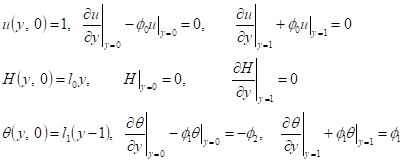
where,
Numenclature
Cp fluid specific heat
K thermal conductivity
u dimensionless velocity
H0‘ applied magnetic field
Hx‘ dimensional magnetic field
H dimensionless magnetic field
y dimensionless distance
t dimensionless time
g gravitational acceleration
b channel width
Re Reynolds number
Kn Knudsen number
Pm magnetic Prandtl number
Gr Grash of’s number
M Hartman number
U0 reference velocity
T0 reference temperature
Greek letters
θ dimensionless temperature
β thermal expansion coeficients
μe magnetic permeability
μ fluid dynamic viscosity
λ molecular mean free path
ξ wall-ambient temperature difference ratio
σ fluid electrical conductivity
ν fluid kinematic viscosity
ρ fluid density
βt,βv dimensionless variables
γ specific thermal ratio
σt,σv heat and tangential momentum accommodation coefficients, respectively.
3.2 Existence and uniqueness of solutions of the model
Theorem : If l(y,t,u,H,θ), m(y,t,u,H,θ), and n(y,t,u,H,θ) are Lips chitz continuous and l0 (y),m0 (y), and n0 (y) are bounded for y∈Rn. Then there exists a unique solution of equations (6) – (8) which satisfy (9).
Proof : We rewrite the equation (6) – (8) as;

, (11)

,
where

For equation (13) to satisfy Lipschitz condition, we most show that

from mean value theorem:
(15)
Therefore,
.
Ignoring the second term at the right hand side, the fundamental solution of equation (10) – (12) are as follows (Toki and Tokis [27]).



Clearly, l(y,t,u,H,θ), m(y,t,u,H,θ), and n(y,t,u,H,θ) are Lipschitz continuous. This completes the proof.
3.4 Analytical solution via OGPAM
Suppose (20)
and let 0<M<<1, Gr=rM such that

equations (6) – (9) were solve analytically using OGPAM (Olayiwola, [19]), and obtained as follows:
(22)
(23)
(24)
where
RESULTS AND DISCUSSION
Free convection flow of fluid has been considered in a vertical micro channel walls. Simulation was carried out to show the effects of the governing parameters by employing Olayiwola’s Generalized Polynomial Approximation Method (OGPAM) on the equations (6) – (9) which were graphically presented. The solutions are computed for the different values of using computer symbolic algebraic package MAPLE 2021 version. The chosen values of the above parameters can be found in the existing literatues such as Jha and Aina [13] and Choudhary et al.[5].
Figure 4.1 and 4.2 show the effects of Reynolds number on velocity distribution against distance and time, Reynolds number is the ratio of inertial force to viscous force. It was observed from these figures that Reynolds number increased the fluid velocity on both walls of the channel, but at later time decrease the velocity. Figure 4.3, 4.4, 4.9 and 4.10 presents the impact of Knudsen number. The Knudsen number also enhanced the slip velocity on both walls and reduced temperature distribution both along distance and time. This type of behaviour of Knudsen number has also been observed by Rashid et al. [21] who investigated the significance of Knudsen number and corrugation on EMHD flow under metallic nanoparticles impact. A high velocity was obtained when increasing the Reynolds and Knudsen number. In figure 4.5 and 4.6, Magnetic pranditl number increased magnetic field within the fluid which was clearly noticed at the second wall of the channel. But as time progresses the nagnetic field get retarded. Similarly, as the value of Eckert number increases, A high temperature of the fluid was observed along distance and at later time decreases which can be seen in figure 4.7 and 4.8. This is due to an increase in friction inside the fluid which transforms the mechanical energy into heat energy. Similar findings of this effect have been reported by Khan and Alzahrani [15] who studied Carreau–Yasuda fluid under Entropy-optimized dissipative flow with radiative thermal flux and chemical reaction.
Figure 4.1: Effect of variation of velocity distribution with Reynolds number against distance.
Figure 4.2: Effect of variation of velocity distribution with Reynolds number against time.
Figure 4.3: Effect of variation of velocity distribution with Knudsen number against distance.
Figure 4.4: Effect of variation of velocity distribution with Knudsen number against time.
Figure 4.5: Effect of variation of magnetic field with magnetic Prandtl number against distance.
Figure 4.6: Effect of variation of magnetic field with magnetic Prandtl number against time.
Figure 4.7: Effect of variation of temperature distribution with Eckert number against distance.
Figure 4.8: Effect of variation of temperature distribution with Eckert number against time.
Figure 4.9: Effect of variation of temperature distribution with Knudsen number against distance.
Figure 4.10: Effect of variation of temperature distribution with Knudsen number against time.
CONCLUSION
The magneto hydrodynamic of free convection flow of fluid in micro channel in the presence of viscous dissipation between vertical parallel two walls was investigated analytically. The condition for the existence and uniqueness of solution of the model equations were established using the approach of Lipschitz continuity. Effects of flow parameters on the velocity profile, magnetic field and temperature profile are graphically presented and we concluded as follows:
- It was found that increase in Reynolds number in reased the velocity profile and thereafter reduced wirh time.
- Increase in Knudsen number enhanced the slip velocity and decreased the temperature profile.
- Magnetic Pranditl number increased magnetic field and at later time reduced the magnetic field.
- Temperature of the fluid flow increased along distance and time, as the value of Eckert number increases.
Competing interests
None.
REFERENCES
- Ahmed, N., Shah, N. A., Ahmad, B., Shah, S. I. A., Ulhaq, S. & Rahimi-Gorji, M. Transient MHD convective flow of fractional nanofluid between vertical plates. Journal of Applied and Computational Mechanics, 5(4), (2019), 592-602, DOI: 10.22055/JACM.2018.26947.1364.
- Awan, A. U., Ali, Q., Riaz, S., Shah, N. A., & Chung, J. D. A thermal optimization throughan innovative mechanism of free convection flow of Jeffrey fluid using non-local kernel. Case Studies in Thermal Engineering, 24, (2021), 100851.
- Buonomo, B. and Manca, O. Natural Convection Flow in a Vertical Micro-Channel with Heated at Uniform Heat Flux, Internatiomal Journal of Thermal Science, 49, (2012), 1333–1344.
- Chen, C. K. & Weng, H. C. Natural convection in a vertical microchannel, Journal of heat transfer. 127, (2005), 1053–1056.
- Choudhary, S., Choudhary, P., Alessa, N. & Loganathan, K. (2023). MHD thermal and solutal stratified stagnation flow of tangent hyperbolic fluid induced by stretching cylinder with dual convection. Mathematics, 11, 2182. https://doi.org/10.3390/math11092182.
- Dwivedi, N. & Singh, A. K. Transient free convective hydromagnetic flow in an infinite vertical cylinder with hall current and heat source/sink. Heat Transfer-Wiley, 1-18, (2020), DOI: 10.1002/htj.21818.
- Gambo, D., Yusuf, T. S., Oluwagbemiga, S. A., Kozah, J. D. & Gambo, J. J. Analysis of free convective hydromagnetic flow of heat generating/absorbing fluid in an annulus with isothermal and adiabatic boundaries, Partial Differential Equations in Applied Mathematics, (2021), https://doi.org/10.1016/j.padiff.2021.100080.
- Hajizadeh, A., Shah, N. A., Syed Inayat Ali Shah, S. I. A., Animasaun, I. L., Rahimi-Gorji, M. & Alarifi, I. M. Free convection flow of nanofluids between two vertical plates with damped thermal flux. Journal of Molecular Liquids, 289, (2019), 110964.
- Hamza, M. M. Free convection slip flow of an exothermic fluid in a convectively heated vertical channel. Ain Shams Engineering Journal, 9, (2016), 1313 – 1323 http://dx.doi.org/10.1016/j.asej.2016.08.011.
- Hamza, M. M., Shuaibu, A. & Kamba, S. A. Unsteady MHD free convection flow of an exothermic fluid in a convectively heated vertical channel filled with porous medium. Scientific Report. (2022), 12:11989 | https://doi.org/10.1038/s41598-022-16064-y.
- Jha, B. K. Aina, B. & Ajiya, A. T. MHD natural convection flow in a vertical parallel plate microchannel. Ain shams Eng Journal. 6, (2014), 289–295.
- Jha, B. K. & Aina, B. Role of induced magnetic field on MHD natural convection flow in vertical microchannel formed by two electrically non-conducting infinite vertical parallel plates. Alexandria Engineering Journal, 55, (2016), 2087–2097.
- Jha, B. K. & Aina, B. Impact of induced magnetic field on MHD mixed convection flow in vertical microchannel formed by non-conducting and conducting infinite vertical parallel lates. Journal of Nanofluid, 6, (2017), 1–11.
- Kalita, D., & Ahmed, N. Transient MHD Free Convection from an Infinite Vertical Porous Plate in a Rotating Fluid with Mass Transfer and Hall Current. Journal of Energy, Heat and Mass Transfer, 33(1), (2011), 271-292.
- Khan, M. I. & Alzahrani, F. Entropy-optimized dissipative flow of Carreau–Yasuda fluid with radiative heat flux and chemical reaction, Europian Physical Journal Plus, (2020), 135:516, https://doi.org/10.1140/epjp/s13360-020-00532-3.
- Mahjabin, S. & Alim, M. A. Effect of Hartmann number on free convective flow of MHD fluid in a square cavity with a heated cone of different orientation. American Journal of Computational Mathematics, 8, (2018), 314-325, http://www.scirp.org/journal/ajcm.
- Mathur, P., & Mishra, S. R. Free convective Poiseuille flow through porous medium between two infinite vertical plates in slip flow regime Pramana – Journal of Physics, (2020), 94:69, https://doi.org/10.1007/s12043-020-1916-y.
- Na, W., Shah, N. A., Tlili, I., & Siddique, I. Maxwell fluid flow between vertical plates with damped shear and thermal flux: Free convection. Chinese Journal of Physics,65, (2020), 367-376.
- Olayiwola, R. O. Solving parabolic equations by Olayiwola’s generalized polynomial approximation method. International Journal of Mathematical Analysis and Modelling, 5(3), (2022), 24 – 43.
- Ramadan, K. M. Slip effects on steady and transient stagnation-point heat transfer in axisymmetric geometries. Journal of Mechanical Engineering Science, 228(15), (2014), 2765–2777.
- Rashid, M., Shahzadi, I. & Nadeem, S. Significance of Knudsen number and corrugation on EMHD flow under metallic nanoparticles impact, Physica A, 551, (2020), 124089.
- Rao, P. S., Prakash, Om., Mishra, S. R., & Sharma, R. P. The transient free convection magnetohydrodynamic motion of a nanofluid over a vertical surface under the influence of radiation and heat generation. Indian Journal of Geo Marine Sciences, 49 (05), (2020), 889-897.
- Ojemeri, G. & Hamza, M. M. Heat transfer analysis of arrhenius-controlled free convective hydromagnetic flow with heat generation/absorption effect in a micro-channel. Alexandria Engineering Journal, 61, (2022), 12797–12811.
- Sambath, P. Pullepu, B., & Kannan R. M. Unsteady free convective MHD radiative mass transfer flow past from an inclined vertical plate with heat source and sink. AIP Conference Proceedings 2112, (2019), 020005, https://doi.org/10.1063/1.5112190.
- Shu, J. J., Teo, J. B. M. & Chan, W. K. Fluid Velocity Slip and Temperature Jump at a Solid Surface. Applied Mechanics Reviews. (2017), doi:10.1115/1.4036191.
- Sobamowo, M. G. Transient free convection heat and mass transfer of Casson nanofluid over a vertical porous plate subjected to magnetic field and thermal radiation. Engineering and Applied Science Letters, 3(2), (2020), 9-18; doi:10.30538/psrp-easl2020.0037.
- Toki C. J. and Tokis J. N. Exact solutions for the unsteady free convection flows on a porous plate with time dependent heating. ZAMM Journal of Applied Mathematics and Mechanics, 87, (2007). 4 – 13.
- Weng, H. C. and Chen, C. K. Drag reduction and heat transfer enhancement over a heated wall of a vertical annular micro-channel, International Journal of Heat and Mass Transfer, 52, (2009), 1075–1079.

